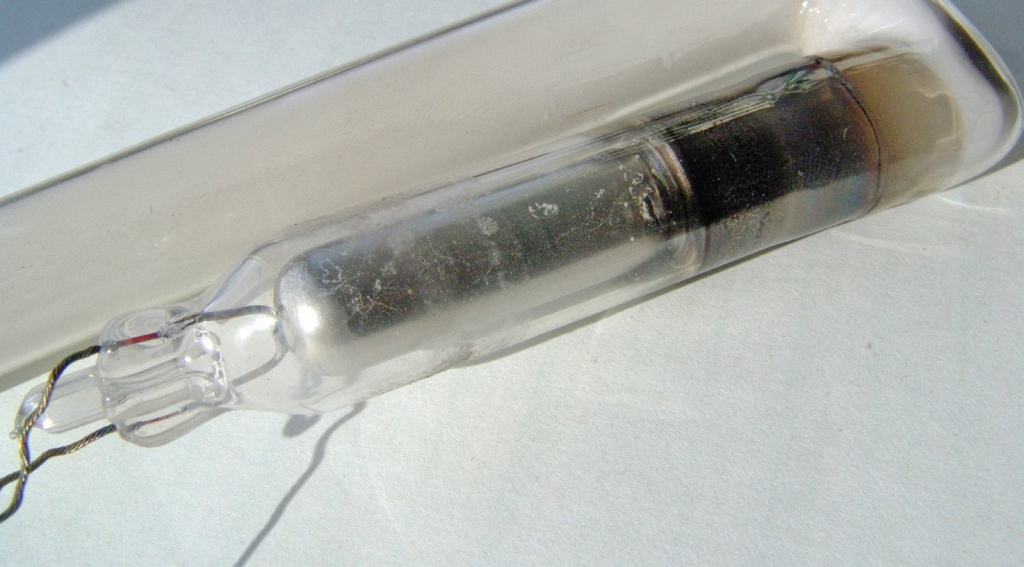Neon signs are known for their lengthy lifespans – some have been reported to operate 24/7 for more than 60 years. But, when a neon sign reaches its end, when the tubing has gone bad and a signshop is called to make a repair, a sign’s smallest neon tube is usually the main culprit in its failure.
Looking more closely at why the tube failed (often prematurely), the neon shop typically claims that we’ve “done it the same way as ever,” pointing to a material defect. But, after digging deeper, the tube-filling pressure – often set to follow a chart supplied by a transformer manufacturer – turned out to be incorrect. The person pumping the tube is always blamed first, although the chart he followed has often neglected important facts.
I’ll outline many of these facts. However, we can summarize that not all parameters affecting a neon tube’s lifetime are known, including which tube-filling formula was followed. The analysis will remain incomplete because the physics of gas discharges and plasma are still subject to ongoing research. Experience has shown that neon-tube filling pressure influences the tube’s lifetime by its fourth or fifth power.
Gas consumption
Historically, the first gas-discharge lamps (Geissler tubes, Moore lamps) were filled with gases that could undergo chemical reactions, and most of the reaction products were solids. Given the limited amount of gas inside the tube, its functional lifetime was exhausted when most of the gas was lost to chemical reactions.
Once Georges Claude pioneered the use of neon (and other noble gases) to create luminous tubing, chemical reactions were eliminated because, with very few exceptions, neon doesn’t undergo chemical reactions. This greatly extends the lighting’s lifetime. If chemical reactions are eliminated, how else may gas dissipate within tubing? First, gas may diffuse through the glass. However, except for helium gas combined with quartz glass – a rare luminous-
tubing combination – this very rarely happens; the common gases used in neon signs (neon, argon, krypton) are practically impermeable with all glass types. So, ignore this as a possible reason.
The next process to consider is occlusion. Occlusion refers to gas being absorbed in interstitial pores, like water in a sponge. The structure of typical soda-lime glass (Fig. 1) bears tiny voids between silicon dioxide tetrahedron. Neon gas can migrate there. The amount of gas occlusion increases with time as ionized neon atoms are shot with high kinetic energy into the voids.
This process absorbs some of the neon, which you can see if you repair an old, clear red-neon tube. When the glass gets hot during bombardment, the gas is released from it and the tubes often turn a reddish-orange color, as if they’re already filled with neon gas.
Metal methods
The most important occlusion process involves metals. Unlike glass, metals are polycrystalline materials with intergranular membranes or voids. Here, the inert gas can and will go in. The gas can be released by heating the metal; the amount of gas occluded is remarkably high.
This is the reason why non-activated electrodes also have to be heated red-hot during bombardment; they release occluded air. If this isn’t done properly, as every experienced pumper knows, the tubes won’t generate the desired color, and they’ll run hot due to the air released into the sealed lamp.
This occurs because the release of the occluded gas is a thermal process. Depending on the internal pressure (read: the amount of gas already occluded) in the operating tube, we always have two parallel, contrary processes: the occlusion and release of noble gases. You acheive an equilibrium if the same amount of gas is released and occluded at the same time.
During neon-tube fabrication, the electrode metal is free of occluded gases. All gas resides in the tube. When sealed-tube operation starts, occlusion initially dominates because the metal doesn’t contain enough gas to release much. Obtaining equilibrium happens gradually.
During the process, gas pressure falls continuously; more is occluded than released. Once the tube reaches equilibrium, gas pressure stays stable. When gas pressure is stabilized, the neon tubes obtain the proper operating voltage, which follows a transformer manufacturer’s loading charts.
Part of the process takes place during tube aging in the neon shop. As the gas pressure and operating voltage change, it’s not suitable to check transformer loading with tubes that aren’t well aged (less than 18-24 hours, depending on manufacturer guidelines). However, with prolonged operation, the metal gradually occludes more gas than is released, albeit at a very slow rate.
Sputtering
The situations described above only relate to normal tube operation. When the tube’s operating voltage exceeds a normal level (sometimes visible because of slight flickering), the gas pressure has reached a critically low value. If there are fewer gas atoms, ionized atoms can be accelerated to much higher speeds before colliding with another atom.
Kinetic collision energy at lower pressures is higher. This energy can get so high that upon a collision with the electrode metal, metallic parts (usually not single atoms) are kicked out from the massive metal body. The metallic parts are then deposited on whatever surface they hit on a straight-line path.
At first, this process takes place inside a hollow electrode shell (see photo 1). But, the deposited metal parts don’t form a solid body; rather, they create a spongy structure. This spongy structure quickly occludes an enormous amount of gas. The gas pressure drops further, accelerating the sputtering process. Therefore, in a rather short time, all gas inside the tube is occluded into a metal, and is no longer available to light up our tube. The tube is “dead.”
To prevent this scenario, we have to anticipate what will happen inside the tube. This means we have to fill it with so much gas that the equilibrium pressure ends up where we want it (with some reserve for a healthy tube lifetime): the minimum operating voltage per tube-unit length for a given diameter, as taken from Fig. 2. As I’ve said, the total amount of gas inside a tube is the tube’s internal volume multiplied by the pressure at which it’s filled.
Gas occlusion mainly depends on the electrode’s metal surface and volume. Most transformer-loading charts are wrong; they don’t list tube volume, an important factor. Most loading and filling charts only list gas pressure for a given diameter, and perhaps include a rule of thumb, such as “for units shorter than 3 ft., add 2 torr.” But, this is too vague, and filling based on such incomplete information is likely to cause problems in a tube’s lifetime.
Consult the charts
It makes a big difference in the amount of gas consumed by occlusion if you are using 15/30 short-shell electrodes or 15/90 electrodes, which have a tri-fold metal surface. Correspondingly, 15/90 electrodes absorb three times more gas than 15/30 electrodes until they reach the equilibrium.
In Fig. 3 and Fig. 4, I have calculated filling pressures for typical electrode sizes and tube lengths. Note that pure neon (red gas) requires higher filling pressure than argon or mercury (blue gas). This is caused by differing atomic masses and diffusion coefficients. If these charts don’t match the tube size you have to fabricate, use the nearest higher filling-pressure curve. This might slightly raise your required transformer voltage (you always need 6-10% of reserve voltage to cope with old tubes and cold weather), but extending the lifetime of your tubes will make your customers happy.



 Business Management1 week ago
Business Management1 week ago
 Women in Signs1 week ago
Women in Signs1 week ago
 True Tales2 weeks ago
True Tales2 weeks ago
 News2 weeks ago
News2 weeks ago
 Editor's Note5 days ago
Editor's Note5 days ago
 Maggie Harlow2 weeks ago
Maggie Harlow2 weeks ago
 Line Time1 week ago
Line Time1 week ago
 Product Buying + Technology6 days ago
Product Buying + Technology6 days ago









